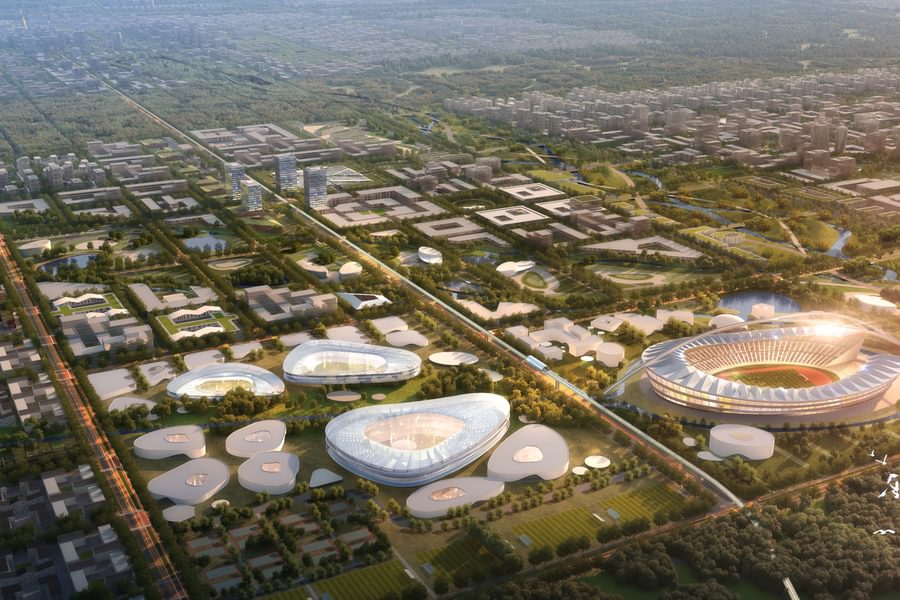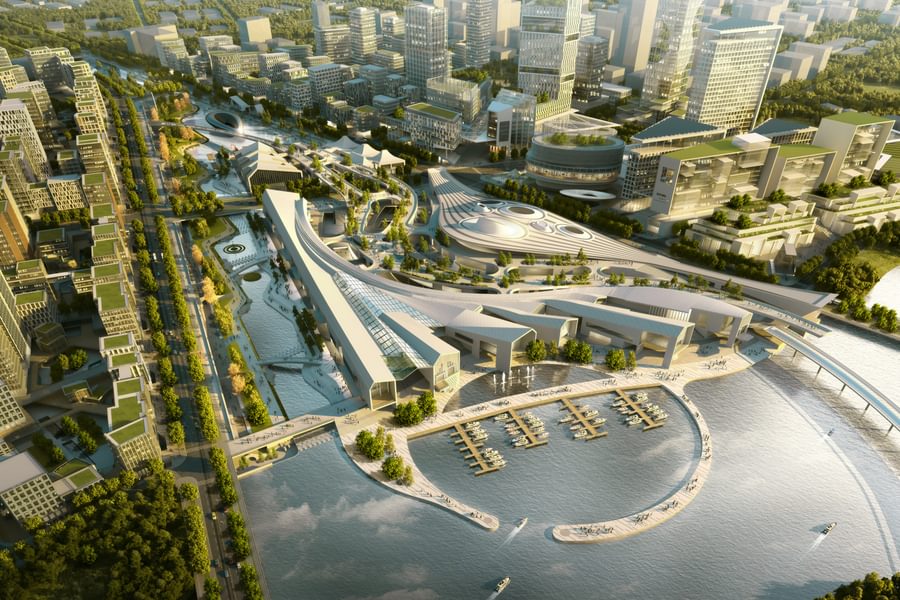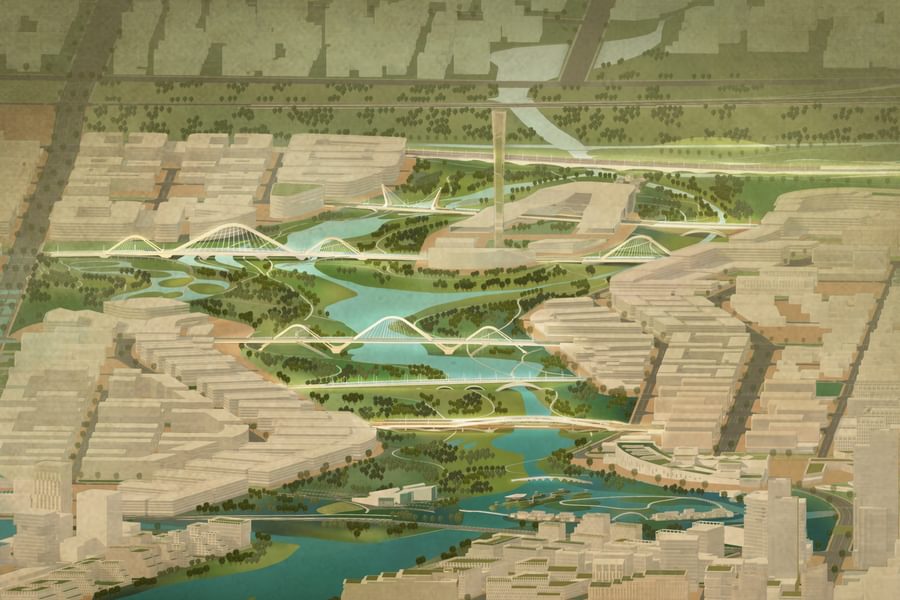
Project profile: Xiong’An: masterplanning a new 272km² Chinese Smart City
The 272km² Xiong’an New Area is a government-supported urban development project that will create a high-quality, efficient and smart city environment. Chapman Taylor’s competition-winning masterplan incorporates technologically advanced and environmentally sustainable designs.
Chapman Taylor Shanghai Associate Director Yichun Xu outlines why there is a need for this new city, how Chapman Taylor became involved in the project and explains the principles of Sponge Cities, 15-minute Cities and Smart Cities.
Why is there a need for a new city?
More than ten years ago, central government started to become aware of the issue that many key resources are condensed into the capital city, Beijing. Having such a high concentration of mixed-use functions leads to problems such as congestion and pollution. Also, in cities like Beijing, there’s a population explosion and a housing shortage.
So, the government realised that it needs to put some non-capital functions elsewhere to relieve the burden. In the future, Beijing will become more of a political centre like Washington D.C. It will also house the international communication exchange centre, the national and cultural centre and the scientific and technical creative centre.
Some non-capital functions, such as financial and educational functions, will be accommodated in Xiong’An. The city is also an opportunity to test new economic policies, social management regulations and urban design strategies. Once successful, the new game rules could be applied nationally.
How was the site identified?
They chose the location firstly because of its adjacency to Beijing and accessibility. It’s also just 20 minutes on express rail from Tianjing and close to Daxing Airport. The construction of the new airport and high-speed railways ensure the viability of developing surrounding land, creating the potential for the city to become a new engine for the modernised economy.
Secondly, the area contains unique ecology (such as the largest freshwater lake in the northern part of China, Baiyang Lake). Thirdly, there’s plenty of undeveloped land so the area has great potential.
Why did they pick Chapman Taylor?
The Chinese government is open to working with international architects. It embraces outside perspectives and creative thinking whilst at the same time ensuring the preservation of the Chinese spirit and culture.
Chapman Taylor has developed a good reputation in China over a number of years.
After winning the 272km2 Xiong zan masterplan, we’ve won other projects in Xiong’an such as the Xiong’an Intercity Express Railway Station Urban Design. The Express Railway is a very important mode of transportation in China.
There’s a lot of trust in us and they know we always produce reliable, high-quality design with great respect for the Chinese culture and people.
What are the main elements of the project?
Our concept was to build a “city with a heart”, as we believe the greatest natural resource a society has is its people and its success depends on how they are nurtured and cared for. We wanted to build a city with a harmonious spirit; a sponge city with water and greenery intertwined.
Fingers of green space come from the parks and point into the various clusters towards the high buildings, into the TOD areas of the masterplan.
We’re creating sustainable buildings by implementing Modular construction principles, ensuring less disturbance to the environment and minimising the wastage of materials
A rich variety of sustainable green building strategies were applied to the project to ensure low energy consumption, low carbon emission and efficient use of clean energy including using the local geo-thermal resources. Renewable energy is applied in the design to build a green, low-carbon and sustainable energy system.
We wanted the city to be healthy, diverse and smart.
Healthy: At the heart of our project is the aspiration of making this new city an international exemplar of the synergy and balance between vibrant city life and its rejuvenating ecology.
Diverse: Enhance the quality of life and sense of belonging of the people living there, through its connections, communities and the quality of its spaces and places. This includes incorporating effective mobility and valuing the streets as public spaces. The city will be built on 15-minute walking city principles (more on this below).
Smart: We will demonstrate sustainability, scalability, flexibility and resilience over an extended timeframe. Smart city principles (more below) will be embodied within social infrastructure, physical infrastructure, institutional infrastructure (including governance) and economic infrastructure.
How have you used Sponge City principles in your planning?
Respecting natural resources is so important. We undertook GIS analysis to identify the areas that were best placed for parkland and areas for urban development. Using this quantitative analysis of the site’s ecological characteristics we proposed the diversion of water to serve the needs of the developing city with low impact on the environment.
On a macro level the “Sponge City” design makes the city flood resistant. The river is linked to the lake, so the whole area is ecologically connected and the different corridors continue to be sustainable. The water flows systematically and can be collected easily.
Because we fully respected the ecological system and the topography we can make sure that the construction has no impact on the diversity of the whole area.
There are also some micro level Sponge City functions, such as curbside raingardens which filter, absorb and detain street run off and allow water to return naturally to the water table. In addition penetrable materials are proposed and planting local not imported vegetation is a key principle of the masterplan. Green energy is incorporated to support the whole area.
Can you explain what is meant by the “15-minute City” or “15-minute Living Circle”?
In a nutshell, both terms mean that everything is accessible within a 15-minute walk.
We did some research based on Chinese people’s demands. What the diagram shows is the different needs for different age groups. Theoretically, daily needs are accessible within your 5-minute living circle. Your weekly needs would be 10 minutes away and the 15-minute facilities are the things you need occasionally, say, monthly or seasonally. It’s a very logical way to design a city.
We’ve also evaluated green transportation options, such as building up public transport + bike + walking modes and we estimate that the proportion of green transport trips will reach 90%.
Smart City
In Xiong’An, we will strive to reduce the impact of uncertainty. We recommend that the city is run on Smart City principles; it’s part of our thinking and would help the strategic management of the city. It’s quite hard to apply in macro terms, but on a more micro level it’s related to smart mobility, healthcare, security, energy, waste and water. Such as, the transportation system would be fully ‘smart’ and able to react to blocks in traffic, reset signals and redirect the flow of traffic accordingly, without the need for human intervention. Taking it even further, for example in healthcare terms, you could look at prescriptions being automatically tailored to people’s requirements, such as dosage being automatically administered in the correct proportions based on someone’s height and weight.
What’s next for the project?
Xiong’An Intercity Station is very important to get right. It’s the second TOD project we’ve won in China and probably our most complex. The station itself connects to many other transport hubs such as a boat dock, bus terminal, city terminal and subways. Its function is to gather people quickly and help them orientate themselves. It’s also so important as it will be the face of the city, so the design needs to be beautiful and incorporate Chinese elements in its interiors. The circulation must be functional and flexible – not just one fast channel; the walking routes need to be broken up with commercial elements to make it more interesting. Winning this project has led to a lot more invitations to pitch for other TOD projects.
We also have the design of 19 Xiong’An bridges; bridges are another new area for us and we’re really building our expertise.
The government will now take our designs and reflect them into the regulatory designs. It's a long process and we’re looking forward to the next stage.







